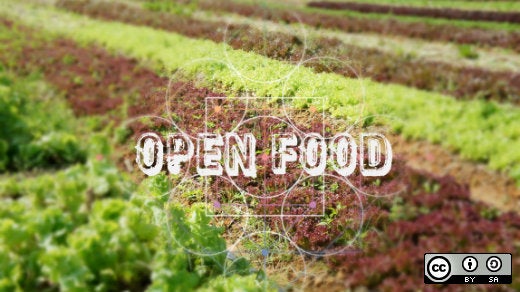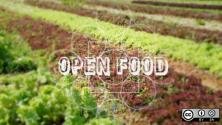We all need to eat, and we know that good nutrition is an important component of a long and healthy life. Daily we read about genetically modified food and the dangers inherent in a system rife with food that's been altered by biotechnology. And, if you're like me, you begin to wonder, "Where can I get good food?"
My wife and daughter have been an inspiration for me to eat better. They want to be able to shake the hand of the person that grew their food. Their inspiration, along with my keen interest in the open source culture, led me to the Open Food Network.
The Open Food Network is a free, open source, scalable e-commerce marketplace and logistics platform that enables communities and producers to connect, trade, and coordinate the movement of food. It was founded by Serenity Hill and Kirsten Larsen, and besides being a network of consumers and producers, Open Food Network is built on free and open source software and released under AGPL license. Plus, anyone can contribute to the project on GitHub.
To learn more about the project I contacted Serenity, who shares with us her insight into this great project.

Tell us about yourself. How did you get started with the Open Food Network?
Kirsten and I used to both work in government in environment and climate change related policy. That's where we met. We were both interested in food systems and both pursued this subsequently through academia before we decided we wanted to actually do something.
I come from a farm, and my parents still have a beef and sheep farm. My PhD research involved in-depth interviews with farmers and food systems analysis. It became very clear to me from my research and my own experience that we would not see significant adoption of sustainable/regenerative agricultural practices unless farmers had real alternatives to commodity markets (a market that trades in primary economic sector rather than manufactured products).
When selling into commodity markets, the margins are small and farmers have little power. There is also incentive to "drive the land" harder than they would otherwise want to. (They have to to make ends meet.)
So Kirsten and I started in 2011 to think about systemic interventions in food distribution so we could scale up opportunities for regenerative farmers. We talked to leaders in alternative food distribution in Australia and also traveled around the United States talking to local food enterprises (Oklahoma Food Cooperative was a particular inspiration). Everyone seemed to be having issues with software and sinking a lot of money into their own systems with no easy way to collaborate with others with the same problem. We could also see potential for a networked approach, rather than software designed to support a single food hub (i.e., so farmers can list products being sold through multiple hubs).
We could see that a major problem with the existing food system was concentration of power in the supply chain, so a major and central design feature was to enable (price/source) transparency in a distributed system (and therefore a well functioning market).
We started off with our own money, farmer and eater friends, and a prototype that our housemate at the time spun up for us. We started to move food in this small experiment and learned a lot. We set up the nonprofit software foundation in October 2012 and received our first major grant in 2013. In 2012 we met Rohan Mitchell, an experienced developer who wanted to contribute more to the world. We have subsequently been very lucky in attracting highly skilled developers who share our vision. We got where we are with some philanthropic and government funding and a lot of volunteer contribution!
What really excites you about making systemic improvements to the food system?
Food is very real and tangible to people. People are genuinely excited about connecting with farmers and reconnecting with earth through food. More than 30% of emissions are from the food system, and in Australia it also consumes 90% of all potable water and accounts for 60% of all land use. By speeding up transition to regenerative agra-ecological systems, we can also draw down carbon from atmosphere. I really think it's our only hope of substantial response to climate change. So I'm excited, but my work in the food system is also driven by genuine fear about the scale and potential impact of climate change and ecological collapse.
How do you see Open Food Network contributing to the food system?
Open Food Network provides the infrastructure for a whole lot of farmers, eaters, and creative enterprises to connect and self-organize to build food systems that serve their interests and that of the ecosystems on which we depend. The inspiration for that was Mycelium (the fungus).
We are excited by the potential for Open Food Network because there are lots of different ways that people can/could use it.
How has the software you are developing contributed to the growth of farms and farmers in the network?
We are an open source software project, but we work very differently to most open source projects in that our stakeholders aren't predominantly developers—they are food businesses and farmers. We provide Open Food Network as a service. We are working on ways to collaboratively design and crowdfund new features with our users. This is a challenge and interesting problem in itself.
What are your prospects for growth of the network worldwide? Where besides Australia is the network growing?
We have nonprofit partner organizations in South Africa, the U.K., Scandinavia, Canada, and France, and have growing networks of potential partners in several other countries including the United States. South Africa has launched and the U.K. is about to. Pilots in other places are in various stages of design and implementation. This provides exciting opportunities to support alternative food networks in other parts of the world and to grow the pool of resources available to continue to improve the Open Food Network for all.
What are your short-term goals?
Our short terms goals are to become financially sustainable! Kirsten and I are working on three levels to affect systemic change in the food system. These projects are at different stages and have different needs. They are all focused on alternative distribution infrastructure—we chose to focus on this area several years ago following insight that we would not achieve large-scale shift to sustainable/regenerative food production unless we provide alternatives to commodity markets at scale. That's the ultimate aim.
-
This social enterprise aims to get member farmers fair prices; provide affordable food to people (particularly disadvantaged groups), and build local economies. It started as a research project in 2013, turned into a small pilot in 2014, and has had some bridging philanthropic project funding for trial operations this year (for a buying groups coordinator). The fledgling project is showing huge promise, but needs philanthropic and government startup support (about $50,000 per year) over 2016 and 2017 to become sustainable and to support its growth in communities where it is most needed . This short video summarizes the potential value of this project.
-
After three years of development with food hub and farmer users, we launched Open Food Network in Australia in June. It makes it easy to find, buy, and sell source-identified food. The Open Food Network infrastructure encourages transparency in the supply network—even if the end customer buys through an intermediary (food hubs, retailers, wholesalers, co-ops, etc.), they can read about the farmer and see how much they got paid. The Open Food Network is not for profit and open source. While we have managed to launch a great product that early users are excited about and willing to pay for, we do not have cashflow to support a dedicated business development and marketing resource in Australia. It's very frustrating! We are seeking venture philanthropy to support this role for 12 months to enable us to cross this bridge and grow into a sustainable business.
-
Open Food Network: Global (open source project)
The potential for Open Food Network to scale to significant global impact was recently recognized in its selection as one of five winners of the global Ouishare Awards. We already have nonprofit partner organizations at various stages of fundraising/pilot/launch in South Africa (launched in September), the U.K., Scandinavia, Canada, the U.S., and France.
The open source nature of project means that we can pool knowledge and resources to a common global infrastructure. However, to get the value out of this distributed contribution, we need to invest in some key mutual roles (Specifically the gap in funding for part-time lead software engineer and community manager roles) so that we can make sure time is spent co-planning and designing features and doing quality assurance/code review/integration so that new features developed by disparate developers/teams get the greatest bang for buck for the whole community (farmers and food hubs using the software all over the world). Again, this is only a short-term requirement (maybe 12-18 months) while partner orgs get established and into a position where they can all contribute percentage of revenue to these core roles.
Where do you see Open Food Network in five years?
In five years, I see Open Food Network tending alternative food systems all over the world, supporting thousands of ethical enterprises, and improving the lives of farmers and consumers. It will be self-sustaining and self-organizing. It will have a lot more really cool functionality. When it comes down to it, we are nerds and love the prospect of more cool and elegant features that make users happy.






Comments are closed.